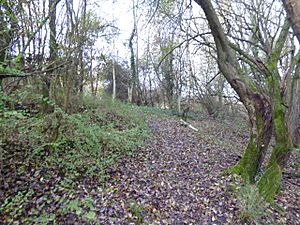Wasing Wood Ponds facts for kids
| Site of Special Scientific Interest | |
 |
|
| Area of Search | Berkshire |
|---|---|
| Interest | Biological |
| Area | 13.5 hectares (33 acres) |
| Notification | 1984 |
| Location map | Magic Map |
Wasing Wood Ponds is a special natural area in Berkshire, England. It covers about 13.5 hectares (which is like 33 football fields!). This site is officially known as a Site of Special Scientific Interest (SSSI) because of its amazing wildlife, especially its many types of dragonflies and damselflies. It was given this special protection in 1984.
Contents
Exploring Wasing Wood Ponds
Wasing Wood Ponds is a unique place with different kinds of watery habitats. It includes several ponds, wet ditches, and marshy areas. Some parts are found within the woods, while others are in open spaces. These open areas were once used for digging up gravel.
Where is Wasing Wood Ponds Located?
This special site is located south of a town called Aldermaston in Berkshire. The area is split into two main parts. While the land is privately owned, there is a public footpath that crosses one of these sections. This means some parts can be explored by visitors.
Amazing Animals of Wasing Wood Ponds
Wasing Wood Ponds is home to many interesting creatures, especially tiny ones! It's particularly famous for its wide variety of Odonata. This is the scientific name for dragonflies and damselflies. These insects are often seen flying around the water.
Meet the Invertebrates
Invertebrates are animals without a backbone. At Wasing Wood Ponds, you can find several cool invertebrate species, including:
- Cordulia aenea (also known as the Downy Emerald dragonfly)
- Brilliant emerald (another beautiful dragonfly species)
- Sympetrum sanguineum (the Ruddy Darter dragonfly)
- Erythromma najas (the Large Redeye damselfly)
Plants and Trees at the Ponds
Just like the animals, the plants at Wasing Wood Ponds are an important part of its ecosystem. They provide food and shelter for many creatures.
Common Trees You Might See
One of the main types of trees found at this site is the Birch tree. Birch trees are known for their distinctive papery bark and slender branches.

